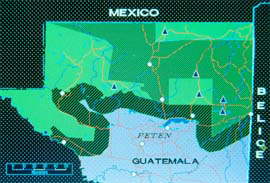 |
THE SELVA MAYA
The Maya Biosphere Reserve
|
 |
Farmers learn of sustainable farming practices
in the Buffer Zone of the Maya Biosphere Reserve.
|
The Biosphere Reserve concept, a UNESCO program, is an important ingredient of global conservation strategy. Unlike national parks, which typically allow no human occupation or extractive uses, biosphere reserves usually allow
some such uses. In this fashion, the biosphere reserve model provides a viable alternative to strict protected areas, which may be politically difficult to designate, especially in nations where there is a great un-met development
need among the human populace.
Typically, biosphere reserves include one or more inviolate core
areas that receive strict protection: only scientific research and perhaps ecotourism are permitted there, but no extractive activities. Surrounding this, like the white of a fried egg (the core area being the yolk),
is typically a multiple
use zone, within which certain economic activities are permitted, managed in a manner consistent with protecting the ecological values of the reserve. Finally, the outer perimeter consists of a buffer zone where yet more human
uses may take place; in this area, efforts are made to promote sustainable land use practices.
 Designated by Guatemalan law in 1990, the Maya Biosphere Reserve comprises the entire northern tip of Guatemala's Department
of Pet�n. Including the buffer zone, the reserve is 21,000 km2 in area, encompassing 19% of the nation of Guatemala. Unlike many biosphere reserves, the Maya Biosphere Reserve (MBR) has several
core areas rather than just one. This arrangement stems from various factors, including the existence of important mayan ruins scattered throughout the reserve, which merit protection. Designated by Guatemalan law in 1990, the Maya Biosphere Reserve comprises the entire northern tip of Guatemala's Department
of Pet�n. Including the buffer zone, the reserve is 21,000 km2 in area, encompassing 19% of the nation of Guatemala. Unlike many biosphere reserves, the Maya Biosphere Reserve (MBR) has several
core areas rather than just one. This arrangement stems from various factors, including the existence of important mayan ruins scattered throughout the reserve, which merit protection.
|
 |
Old Logging Road
|
While much of the reserve has witnessed mahogany logging in the past, in most cases the forest is indistinguishable from virgin forest, apart from a paucity of large mahoganies and the presence of occasional stumps and old
logging roads.
To our knowledge, no species has disappeared from the Maya Biosphere Reserve, although the Scarlet Macaw (Ara macao) population is much reduced from its original size, and in serious need of protection from nest-robbing
possibly for the pet trade. The Harpy Eagle (Harpia harpyja), though still present, is probably also locally reduced in range and population.
|

|
Scarlet Macaw
|
Challenges facing conservation in this region are many, and may be viewed as a microcosm of problems faced in larger regions such as the Amazon Basin.
NEXT

6
|
 |